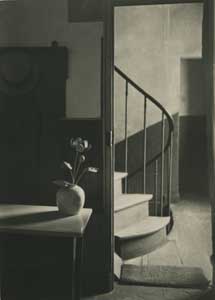Andre Kertesz, Chez Mondrian
 (click here for the Romanian Version)
(click here for the Romanian Version)I went to his studio and instinctively tried to capture in my photographs the spirit of his paintings. He simplified, simplified, simplified. The studio with its symmetry dictated the composition. He had a vase with a flower, but the flower was artificial. It was colored by him to match the studio.
[Andre Kertesz telling the story of this photo]
With their extrem abstractionism the works of Mondrian are very challenging. Can the photos made by Kertesz give us some hints, to progress a little bit in discovering Mondrian's artistic personality? At first view, they are very enigmatic, these photos, Chez Mondrian and at the Modrian's Glasses and Pipe. There are however some very subtle references, and I discovered on the web this essay that made relevant for me the references from the two photos, the thick glasses, the tulip ... one tulip in a vase, an artificial one, its leaves painted white... wearing his heavy glasses, Mondrian seemed more a scientist or priest than an artist:
In his Paris studio he had used flowers to make it more cheerful. One tulip in a vase, an artificial one, its leaves painted white...
The artificial tulip fitted in, of course, with the legend of the studio as laboratory or cell, the artist as scientist or anchorite... Everything was spotless white, like a laboratory. In a light smock, with his clean-shaven face, taciturn, wearing his heavy glasses, Mondrian seemed more a scientist or priest than an artist...
The loneliness of the artificial tulip with its painted leaves might seem to suggest that flora were admitted grudgingly, one plant being the next best thing to none. But it probably meant the opposite of that - was probably a sign, not of Mondrian's having become a different person, but of his having remained the same...
As Mondrian was probably incapable of irony, the tulip was unlikely to be a wry joke about his having had to produce flowerpieces between 1922 and 1925 when he no longer wanted to because there were no buyers for his abstracts...
[David Sylvester, About Modern Art]

0 Comments:
Post a Comment
<< Home